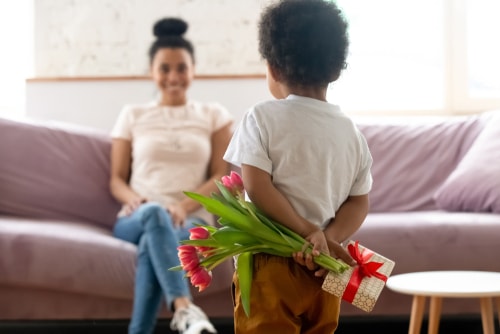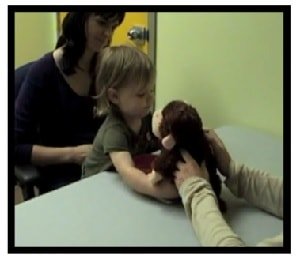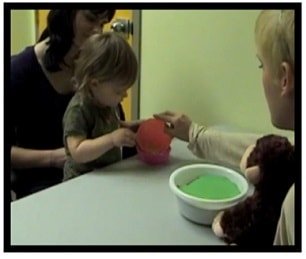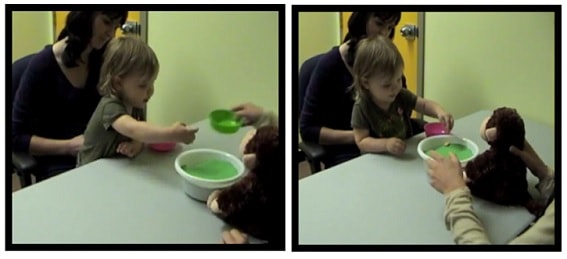Are little kids hopelessly selfish? Many people assume so. But scientific research suggests otherwise. Like adults, children experience the warm glow of giving. And it’s a motivating force for good.

Psychologists call it “the warm glow of giving,” and it’s a well-documented phenomenon among adults. In fact, neuroscientists have tracked it in the brain. When we engage in acts of altruistic giving — helping others at a cost to ourselves — we experienced heightened activity in the brain’s reward centers (Filkowski et al 2016). And what’s interesting about giving is that we don’t become habituated to its effects — not easily.
In experiments where researchers compared giving and receiving, they found that people quickly became accustomed to receiving a daily cash prize. They reacted with progressively less happiness as the week rolled by. But if people gave these daily windfalls to someone else? The happiness didn’t diminish (O’Brien and Kassirer 2019).
So giving to others gives us an immediate, pleasant, physiological rush. Why? It’s probably related to the natural high we experience when somebody smiles at us (Yang and Urminsky 2018). Gift-giving is a pretty reliable way of eliciting that reaction. It may also depend on our ability to empathize and engage in perspective-taking. But whatever the immediate triggers may be, it’s clear that this “warm glow” has good consequences. It motivates us to give. So we’re left with an important question about child development.
Do little kids feel the warm glow? Does it motivate them to give?
Laura Aknin and her colleagues wanted to know, so they designed a pioneering experiment (Aknin et al 2012).

The researchers recruited Canadian toddlers — only 20 to 22 months of age — and introduced these children to a couple of strangers: A friendly human experimenter, and an equally pleasant animal puppet named “Monkey.”
The adult experimenter explained that Monkey liked treats, and pointed out that neither Monkey nor the child had any. Then experimenter pretended to discover some treats. (“Oh look! I found some treats!”) The experimenter gave them to the child.

The researchers were videotaping all of this, so they could capture the child’s emotional reaction when he or she first received the treats. And the camera kept running during the remaining part of the procedure, which included three additional events:
- The experimenter “found” yet another treat, which she gave to the puppet. “Oh look! I found one more treat. I’m going to give it to Monkey!”
- The experimenter found an additional treat. But instead of merely handing it over to Monkey, the experimenter asked the child to play a role. “Oh look! I found one more treat. Will you give it to Monkey?”
- The experimenter pretended to look for further treats. No success. So the experimenter prompted the child to engage in what psychologists call “costly sharing.” The experimenter asked the child to donate a treat from his or her own, personal stash. “I do not see any more treats. Will you give one of your treats to Monkey?”
To make sure the order of these events didn’t affect outcomes, the researchers mixed things up. Some kids experienced the request to share first; others experienced it later, after they’d observed the adult experimenter give Monkey a treat. But by the end, every child had experienced all three events, and kids were cooperative when asked to give.

So how did children feel during the experiment?
When impartial, trained observers looked over the video recordings, they detected a little surge of happiness in children when they first met the puppet. Kids showed considerably less happiness when they received that initial, one-sided windfall of treats. But afterwards, moods improved — especially when kids engaged in sharing, and most especially when kids engaged in costly sharing.
Indeed, the children seemed to enjoy giving more than receiving. They displayed more happiness when they shared treats with Monkey. And the highest levels of happiness? Kids seemed to enjoy themselves the most after they handed over a treat from their own, personal stash.
A fluke? There were only 23 toddlers in this experiment, and we can always question whether the results of one, small study reflect chance factors. We should also be careful about generalizing from one culture to the next. These kids lived in Canada. Maybe Canadian children are raised to feel especially happy about giving.
Yet other, subsequent studies — conducted in several different societies — back up the central idea: Young children get a warm glow from being generous.
For example, Lara Aknin’s group visited an isolated, rural village on Tanna, a small island in the South Pacific.

The researchers conducted the same experiment on a group of 20 kids — children ranging in age between 28 and 50 months — and the results were the same. Kids seemed happier giving than receiving, and they displayed the highest levels of happiness when they gave away their own treats (Aknin et al 2015).
And, more recently, another research team — led by Yue Song — tested Aknin’s experimental procedure on 122 toddlers living in the Netherlands and 91 preschoolers living in China. Once again, the researchers found evidence for the “warm glow” of giving. Kids were happier when they shared — especially when their act of sharing came at a personal cost.
So it really does appear that young children enjoy the act of giving. And there’s additional evidence that such feelings prompt children to be generous. In a study of preschoolers, the kids who were most likely to be generous were the ones who had a conscious understanding of the psychological rewards of giving (Paulus and Moore 2017).
But hang on. How does this jibe with our everyday observations? Of conflicts? Of kids who refuse to share?
If the results of these studies seem to defy your everyday experience — if it seems that your toddler’s favorite word is “mine!” — consider the context. In the puppet experiments, children were guided by a friendly adult, and the amount of generosity requested from them was relatively modest. Kids with several treats were asked to spare a few for someone else.
It was costly sharing, yes, but the cost wasn’t especially high. Nobody asked the kids to hand over their cherished possessions. If your toddler is reluctant to trust her favorite toy with another child, we need to remember: This is a very normal reaction, and it isn’t only toddlers who feel this way.
I suspect most parents aren’t in the habit of sharing their most valued possessions with people they meet on the playground. And for young children, this kind of sharing may feel especially risky. They are lacking in authority, experience, and confidence. If I let Mike play with my toy truck, will he give it back? Maybe not!
So when it comes to these more risky acts of sharing, we need to cut kids some slack. It’s natural for young children to look out for themselves, and research confirms that the willingness to share takes time to develop. For example, 5-year-olds may be more receptive to the idea of sharing than 3-year-olds are (Friedrich and Schmidt 2022).
But none of this takes away from the main conclusion of the “warm glow” experiments. Even very young children get a pleasant buzz from acts of generosity, and that’s something we can build on.
How do we nurture sharing and generosity?
We can encourage kids to be generous by providing them with easy, non-threatening opportunities to give and share. And we can increase the likelihood of sharing by engaging in a little social engineering: Experiments suggest that kids tend to become more generous after we read them stories about characters who give (Russell and Cain 2022). In addition, some young children — those with higher levels of empathy — may become more giving immediately after experiencing a boost of happiness ( Guo and Wu 2021).
It might sound a bit manipulative, and it is. But there’s a crucial caveat: We need to avoid the use of force. When kids are forcibly required to give or share, they don’t experience the warm glow (e.g., Wu et al 2017).
It’s something that modern-day hunter-gatherers seem to understand. Learning to share is essential to their way of life, and they foster it in children from an early age. But they don’t do it by bossing their children around. Instead, the play little sharing games with their toddlers — teaching children to exchange beads and baubles back and forth (Konner 2011). It’s a lesson we might all put to good use.
More information
What else do studies tell us about encouraging generosity in children? Learn more in my article, “Raising helpful kids: Tips for teaching generosity and kindness.” And if you are interested in understanding the development of this behavior, take a look at these Parenting Science articles:
References: Children experience the warm glow of giving
Aknin LB, Hamlin JK, Dunn EW. 2012. Giving leads to happiness in young children. PLoS One. 7(6):e39211.
Aknin LB, Broesch T, Hamlin JK, Van de Vondervoort JW. 2015. Prosocial behavior leads to happiness in a small-scale rural society. J Exp Psychol Gen. 144(4):788-95.
Filkowski MM, Cochran RN, Haas BW. 2016. Altruistic behavior: mapping responses in the brain. Neurosci Neuroecon. 5:65-75
Friedrich JP and Schmidt MFH. 2022. Preschoolers agree to and enforce prosocial, but not selfish, sharing norms. J Exp Child Psychol. 214:105303.
Guo R and Wu Z. 2021. Empathy as a buffer: How empathy moderates the emotional effects on Preschoolers’ sharing. Br J Psychol. 112(2):412-432.
Harbaugh WT, Mayr U, Burghart DR. 2007. Neural responses to taxation and voluntary giving reveal motives for charitable donations. Science. 316(5831):1622-5.
Konner M. 2011. Evolution of childhood: Relationships, Emotion, Mind. Cambridge, MA: Belnap Press.
O’Brien E and Kassirer S. 2019. People Are Slow to Adapt to the Warm Glow of Giving. Psychol Sci. 30(2):193-204.
Paulus M and Moore C. 2017. Preschoolers’ generosity increases with understanding of the affective benefits of sharing. Dev Sci. 20(3).
Russell SJ and Cain K. 2022. The animals in moral tales: Does character realism influence children’s prosocial response to stories? J Exp Child Psychol. 219:105392.
Song Y, Broekhuizen ML, Dubas JS. 2020. Happy Little Benefactor: Prosocial Behaviors Promote Happiness in Young Children From Two Cultures. Front Psychol. 11:1398.
Yang AX and Urminsky O. 2018. The Smile-Seeking Hypothesis: How Immediate Affective Reactions Motivate and Reward Gift Giving. Psychol Sci. 29(8):1221-1233
Wu Z, Zhang Z, Guo R, Gros-Louis J. 2017. Motivation Counts: Autonomous But Not Obligated Sharing Promotes Happiness in Preschoolers. Front Psychol. 8:867
Image credits
Title image by fizkes / shutterstock
Image of Tanna Island village, Vanuatu, by gg-foto/ shutterstock
Images of the child participating in the experiment are from the paper by Aknin and colleagues (2012). They appear here under terms of the Creative Commons Attribution license.
Content last modified 12/16/22. Portions of this text are derived from an earlier version of this article, written by the same author.

